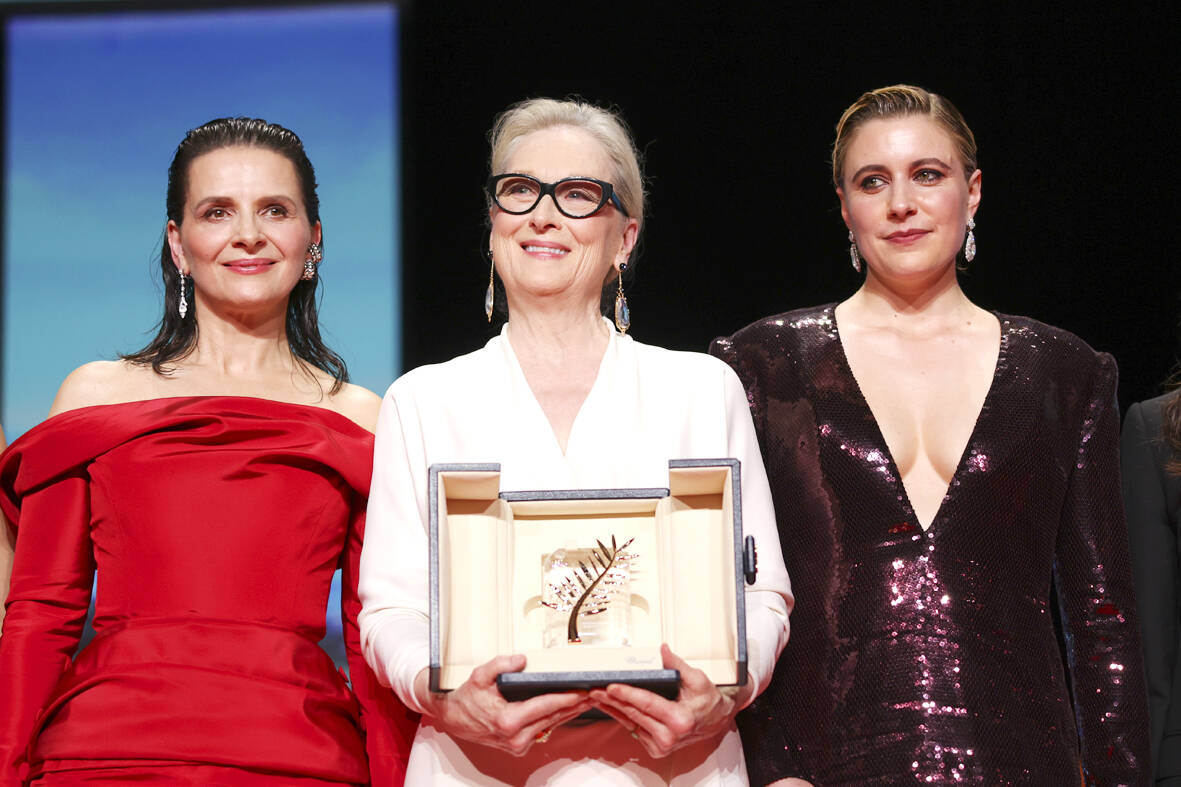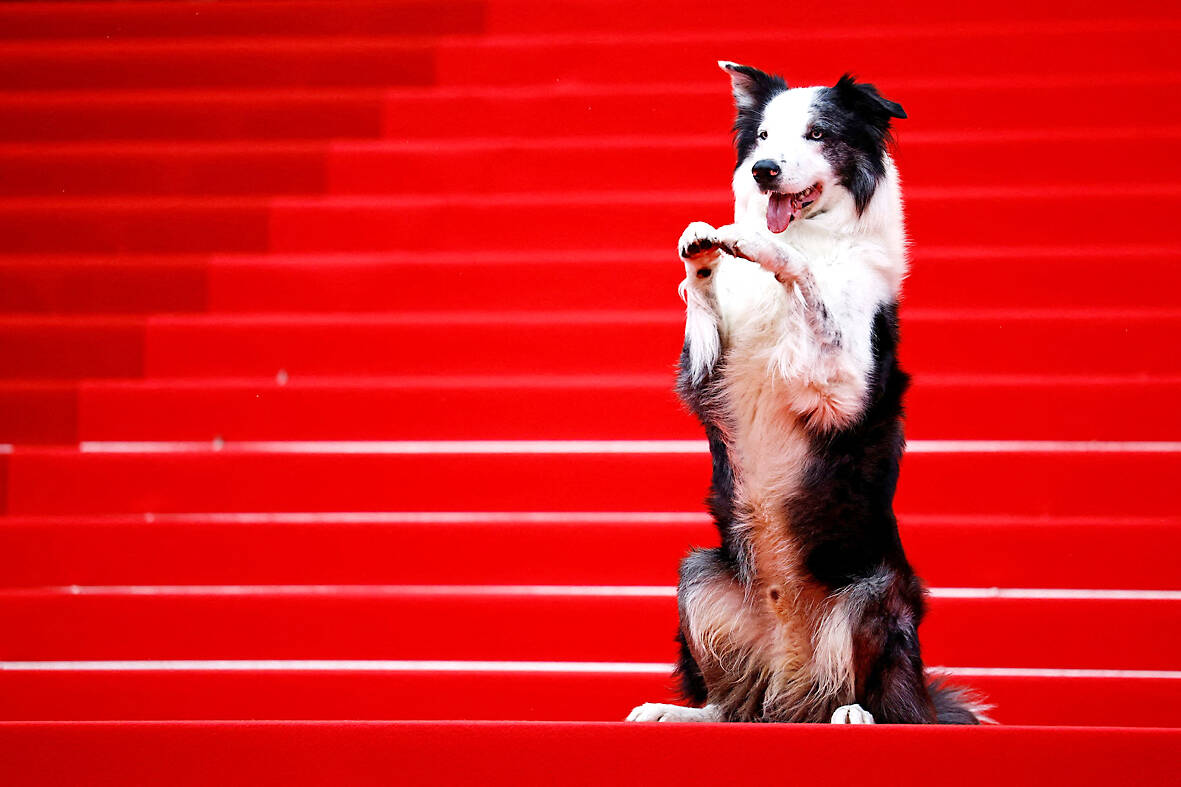The Cannes Film Festival is hallowed ground in cinema but understanding its unique landscape can be confounding.
The Cote d’Azur festival, which kicked off Tuesday, is a 10-day ballet of spectacle and film where even the photographers wear tuxedos, standing ovations are timed with stopwatches and movies tend to be referred to by the names of their directors — “the Almodovar,” “the Malick,” “the Coppola.”
From the outside, it can seem mad. From the inside, it can be hardly less disorienting. But grasping some of Cannes’ quirks and traditions can help you understand just what is unspooling in the south of France and what, exactly, a Palm Dog is.

Photo: AP
WHY DOES CANNES MATTER?
The short answer is that Cannes is the largest and arguably most significant film festival, and few care more deeply about the art of cinema than the French. This is where cinema was born and it’s where it’s most closely guarded. It’s not a coincidence that to enter the Palais des Festivals, the central hub, you must climb 24 red-carpeted steps, as if you’re ascending into some movie nirvana.
Cannes is also singularly global, attracting filmmakers, producers and journalists from around the world. It’s a little like an Olympics for film; countries set up their own tents in an international village. Because Cannes is also the largest film market in the world, many who come here are trying to sell their movies or looking to buy up rights. Deal-making, though not quite the frenzy it once was, happens in hotel rooms along the Croisette, aboard yachts docked in the harbor and, yes, on Zoom calls.

Photo: Reuters
But aside from being a beacon to filmmakers and executives, Cannes is a draw for its shimmering French Riviera glamour. Since the days of stars like Grace Kelly and Brigitte Bardot, Cannes has been renown as a sun-kissed center stage for fashion.
HOW OLD IS CANNES?
Originally called the International Film Festival, Cannes was born in the lead-up to World War II. Venice had launched the first major film festival in 1932, but in 1938, fascist influence on Venice was pervasive. The French government in 1939 chose the tourist destination of Cannes as the place for a new festival — though because of the war, the first edition wasn’t held until 1946. This year’s festival is the 77th edition.
WHAT IS IT LIKE ON THE GROUND?
The hive of activity is the Palais, a massive complex by the sea full of cinemas with names like Bunuel, Bazin and, the granddaddy, the Grand Theater Lumiere. This is where the red carpet runs in Cannes, nightly hosting two or three world premieres beneath a glass canopy flanked by rows of photographers. Festival cars ferry stars and directors who are ushered down the carpet and up the steps. Unlike most movie premieres, there are no reporters on the carpet.
Filmmakers and casts instead face questions from the media the day after their premieres, at a press conference preceded by a photo call. The press conferences can be atypically newsy, too; after Danish director Lars von Trier declared “I am a Nazi” at a Cannes press conference in 2011, he was named “persona non grata” by the festival for years.
Interpreters translate live for headphone-wearing reporters. Inside the Palais, bleary-eyed attendees are treated to gratis espresso.
Down the Croisette, the oceanside, palm tree-lined promenade of Cannes, there are regal old hotels like the Carlton and the Martinez from where festival attendees flow in and out, interviews might be happening on balconies as autograph-seeking fans gather outside in throngs. After-parties are typically held in clubs across the Croisette, by the beach.
WHO ATTENDS?
Unlike public festivals like Toronto or SXSW, Cannes is industry-only and largely out of reach for most moviegoers. That doesn’t stop the desperate, tuxedo-clad ticket seekers who hold signs outside the Palais on the chance someone has an extra, or the photo-takers who stand on small ladders near the red carpet.
Cannes is rigorously hierarchical, with a system of color-coded badges regulating access. If you hear about a film being booed at Cannes — even Martin Scorsese’s Taxi Driver was famously jeered before winning the Palme d’Or — it’s usually at a press screening.
The premieres, largely attended by industry professionals, are where the prolonged standing ovations take place. But this, like many things at Cannes, is a bit of stagecraft to boost the mythology. After the credits role, a cameraman rushes in, with his footage fed live to the screen. He goes down the aisles, giving the audience a chance to applaud for the director and each star. No one is just cheering for a dark movie screen.
WHAT DOES ‘IN COMPETITION’ MEAN?
Cannes hierarchy is in the lineup, too. Attention focuses most on the films “in competition:” usually around 20 movies competing for the Palme d’Or, the festival’s top award. Past winners include Apocalypse Now, Pulp Fiction and Parasite. Last year, it went to Justine Triet’s Anatomy of a Fall. Winners are chosen by a jury of nine that changes every year. This year’s is presided over by Greta Gerwig.
Competition is only one section, though. Many high-profile films might play out of competition, as Furiosa: A Mad Max Saga is this year. Un Certain Regard gathers a lineup of original or daring films. First and second films play in the sidebar Critics’ Week. There are also midnight selections and the recently launched Premiere sidebar, which also takes some overflow for films that didn’t fit into competition. Restorations and documentaries play in Cannes Classics.
And down the Croisette, separate from the official selection, is the Directors’ Fortnight or the Quinzaine, a parallel showcase launched in 1969 by a group of French filmmakers after the 1968 Cannes was canceled.
BUT WHAT ABOUT THE PALM DOG?
There are many other prizes, too, even an unofficial one created by journalists called the Palm Dog (sadly, not the Palme D’Og), for the best canine in Cannes. Last year, that honor went to Messi, the Anatomy of a Fall pooch.
Created in 2001, the annual award and its spinoff categories is decided by a jury of reporters. Past winners have included Uggie from The Artist (2011) and Sayuri, who played the heroic pit bull in Once Upon A Time ... In Hollywood (2019).
As for the reigning champ, Messi captivated the carpet on opening day this year, in town again as a correspawndent of sorts for French television.

May 11 to May 18 The original Taichung Railway Station was long thought to have been completely razed. Opening on May 15, 1905, the one-story wooden structure soon outgrew its purpose and was replaced in 1917 by a grandiose, Western-style station. During construction on the third-generation station in 2017, workers discovered the service pit for the original station’s locomotive depot. A year later, a small wooden building on site was determined by historians to be the first stationmaster’s office, built around 1908. With these findings, the Taichung Railway Station Cultural Park now boasts that it has

Wooden houses wedged between concrete, crumbling brick facades with roofs gaping to the sky, and tiled art deco buildings down narrow alleyways: Taichung Central District’s (中區) aging architecture reveals both the allure and reality of the old downtown. From Indigenous settlement to capital under Qing Dynasty rule through to Japanese colonization, Taichung’s Central District holds a long and layered history. The bygone beauty of its streets once earned it the nickname “Little Kyoto.” Since the late eighties, however, the shifting of economic and government centers westward signaled a gradual decline in the area’s evolving fortunes. With the regeneration of the once

The latest Formosa poll released at the end of last month shows confidence in President William Lai (賴清德) plunged 8.1 percent, while satisfaction with the Lai administration fared worse with a drop of 8.5 percent. Those lacking confidence in Lai jumped by 6 percent and dissatisfaction in his administration spiked up 6.7 percent. Confidence in Lai is still strong at 48.6 percent, compared to 43 percent lacking confidence — but this is his worst result overall since he took office. For the first time, dissatisfaction with his administration surpassed satisfaction, 47.3 to 47.1 percent. Though statistically a tie, for most

In February of this year the Taipei Times reported on the visit of Lienchiang County Commissioner Wang Chung-ming (王忠銘) of the Chinese Nationalist Party (KMT) and a delegation to a lantern festival in Fuzhou’s Mawei District in Fujian Province. “Today, Mawei and Matsu jointly marked the lantern festival,” Wang was quoted as saying, adding that both sides “being of one people,” is a cause for joy. Wang was passing around a common claim of officials of the People’s Republic of China (PRC) and the PRC’s allies and supporters in Taiwan — KMT and the Taiwan People’s Party — and elsewhere: Taiwan and